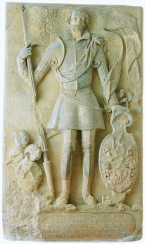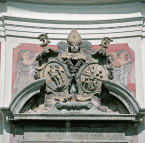Under the rule of the Spanheim family Kostanjevica became a powerful commercial, political and administrative centre by what was then the provincial frontier. In 1234 Bernard von Spanheim founded a Cistercian monastery in the immediate vicinity of Kostanjevica, by the source of the Obrh, in order to further consolidate his economic power and provide his family with a final resting place. He bestowed ample estates on the monastery, with the result that it became one of the richest landowners in the Carniola of the day. At the same time it represented a centre of religious, educational, mercantile and commercial life. At its peak, the monastery was home to 86 monks and lay brothers.
The original Early Gothic monastery was renovated and completed during the Renaissance and Baroque periods. In the first half of the 18th century the Baroque coulisse and two small defence towers with painted decoration by Fran Jelovšek were built and one of the largest arcaded courtyards in Europe was completed. In 1786 Emperor Joseph II dissolved the monastery. Its property was transferred to the Carniolan religious fund, the church fittings sold at auction and the church deconsecrated. The monastery became the headquarters of the forestry administration and the notarial service and was occupied by a large number of tenants. After the Second World War the building complex was used by Agrokombinat, Labod and Iskra. The process of decay began with the dissolution of the monastery and reached its peak with the fire and demolition of 1942/43 and further demolition after the end of the war. The first restoration/protective works were carried out by students of Professor France Stele’s seminar (around 1933), while thorough restoration commenced in 1957, when the bell tower fell down, and is still in progress today. In 1989 the former monastery was proclaimed a cultural monument and is thus classified among those monuments to which the State devotes particular attention. The buildings of the former monastery and their surroundings offer ideal conditions for the organisation of cultural events, concerts and theatrical and operatic performances. In 1974 the Božidar Jakac Art Museum moved to premises at the former monastery.


general information



